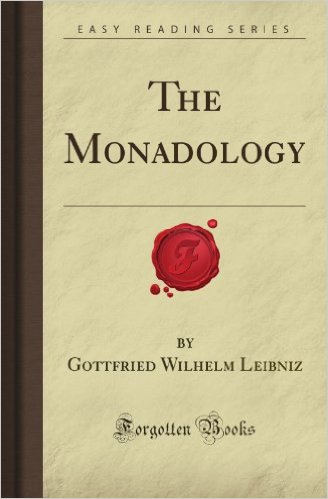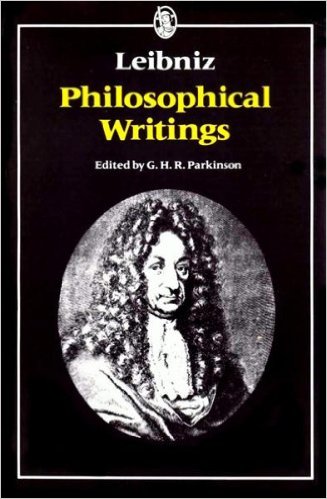The Philosophy
Leibniz, the third and last of the three so-called Rationalists, is one of the few philosophers not to have written a single treatise expounding the ideas at the core of his philosophical thought. Rather, one must piece together his philosophy from a number of essays, letters, and various works left unpublished at the time of his death. Although, having said that, the Monadology does give a good indication of many of his central theses.
Metaphysics
Monads
Much of Leibniz’s metaphysics turns on his conception of what he calls Monads (from the Greek monos, meaning one). Anything in our experience, i.e. anything physical, will always be an aggregate of some kind, that is, composite in nature or made up of smaller parts which are themselves composite in nature. So Leibniz agreed with the ancient Greeks that matter is infinitely divisible, but it can’t be like this all the way down or we end up with an infinite regression. Hence, Leibniz theorised the existence of fundamentally indivisible substances, vis a vis,Monads. These Monads are “simple substances” which ultimately means they; a) are without parts, b) are not extended, c) are completely unique, d) are capable of perception, e) have “no windows”, and f) are mirrors of the universe.
Let’s look at each of those features in a little more detail. Monads have no parts because they are simple as opposed to composite substances. There are no component parts of Monads which means they are fundamentally indivisible. This also means that, since nature operates solely through the assembling and disassembling of physical parts, Monads can neither come into being nor dissolve through natural means. Rather, they must be created or annihilated “all at once”.
Because every physical substance is infinitely indivisible, Monads cannot be extended in space, that is to say, Monads cannot be physical. Instead, they are meta-physical, or beyond the physical, the underlying reality the physical is based on.
No two Monads can be identical; if they were, they would be the same thing.
All Monads are capable of perceiving. No matter how rudimentary this perception or awareness is, each Monad registers, on some level, the world external to it. Now, for Leibniz, perception amounts to change within the Monad. But since change involves a restructuring of the parts of which a thing is composed and since Monads are not composed of parts, this change must derive from some kind of “internal principle”. Leibniz calls this internal principle Appetition, which seems to be something like will.
When Leibniz says Monads have no windows, what he means is that they are completely closed to external influence. Although they can perceive the external world, they can’t actually be affected by it, nor can they affect it, in any way.
Monads are fundamentally ‘perceiving things’. This proposition, combined with the idea of universal harmony, (see next section) in which no Monad (or composite thing) exists independently of the surrounding world but is rather intimately connected through a vast web of causality to a unified whole, prompts Leibniz to call Monads mirrors which reflect the entire universe within them. In this way, Leibniz tries to find some middle ground between the individuality of things and the unity of the universe.
The most basic kinds of Monads have perception only. Above these are special Monads, Leibniz calls souls, which have perception accompanied by memory. Most animals fall into this category. The highest forms of Monads are those with both memory and reason, and these he calls minds or rational souls. This category obviously includes to humans, these days we would probably want to include a few non-human animals as well, and includes the capacity for self-reflection.
Universal Harmony
The universe for Leibniz is a complete, ordered, and harmoniously functioning whole. He saw it, not as a random collection of disparate things, but as a complex, well-ordered web of interconnected parts which are not in fact, separate from the whole.
Cause and effect ultimately link every compound (i.e. physical) substance in the universe, meaning that “every body feels the effect of all that takes place in the universe”. If we were better able to interpret and understand things, we would know everything in the universe just from observing our own perceptions of those things most immediate to us.
Leibniz distinguishes between efficient and final causes. The former refers to changes as they apply to physical bodies while the latter refers to effects arising in souls. Efficient causes are reasonably straightforward, as any experiment with two billiard balls will show. Final causes, on the other hand, operate through ends and means, whereby a particular soul is driven to certain actions, not by the influence of prior ‘things’, but from a desire for a certain outcome or fulfilment of a certain desire that causes a certain action, i.e. a means to an end.
Here we might want to take a second to answer a question that might have occurred to you at the end of the prior section. If Monads have no windows, how can cause and effect have any purchase in the universe? Leibniz created a principle called pre-established harmony which essentially postulates that cause and effect is an illusion.
Pre-established harmony says that when God first created the universe, he set in motion an infinite sequence of events in which each Monad (and therefore each composite substance too) would act in perfect concert with every other Monad, despite not actually, directly affecting each other.
This also gave Leibniz the solution to the Cartesian problem of how immaterial souls and physical bodies interact. They don’t. It seems like they do but that is just because God “pre-established” every event at the beginning of the universe. Leibniz explained this by imagining two clocks, a soul clock and a body clock. When a soul event takes place and we see a corresponding body event occur at the same time, this is not due to a causal relationship between the two, but rather it happens because both events were caused by God.
God
Since God underwrites Leibniz’s entire metaphysics, he is wholly committed to the ‘fact’ of his existence. He agrees with all of the arguments offered by his predecessors including the ontological argument and the arguments from causality advanced by the Scholastics, and contributes something of his own with another principle, that of sufficient reason.
The principle of sufficient reason states that there can be no fact or true statement without a sufficient reason explaining why it is thus, even if that reason is often unknown by us. In looking back to the past for a sufficient reason for any current state of affairs, we find a certain number of immediate efficient and final causes, and in looking further back for sufficient reasons of those causes, we find exponentially more. In fact, if we assiduously search for a sufficient reason for any current event, all we find is an infinite number of efficient and final causes, paradoxically leading us further from our target.
Since looking back through the causal sequence of contingent things fails to get us any closer to a sufficient reason, Leibniz concludes we must look outside this causal chain to a necessary being, namely, God.
And then Leibniz goes to work getting all of the usual attributes we associate with God. Since he is a sufficient reason for every contingent thing, he must be singular. Since everything in the universe is related to him, he is universal. Since he contains all possibilities within himself, he must be free from limits, that is, infinite. And he is of course, absolutely perfect.
The Problem of Evil
The problem of evil is a longstanding objection against the existence of God. It asks how evil can exist in a world with an all-good and all-perfect God. Leibniz attempted to answer this question as follows.
For Leibniz, perfection includes the idea of being free from limits. God is the absolute example of this, being absolutely infinite. Anything less than God must, by definition, be limited and therefore all contingent beings, prior to sin, just by the very nature of existing, are imperfect, that is to say, evil. Leibniz calls this metaphysical evil and is completely unavoidable, even by God, because it arises in the very essence of contingent beings. Leibniz illustrates this kind of evil with the analogy of boats floating down a river. The current of the river flows past each boat at exactly the same rate but the heavier boats travel slower, clearly through no fault or limitation of the river. Rather, it is because of the heavier boats themselves that they travel more slowly. In the same way as the river is the cause of the motion, not the retardation of the boats, “God is the cause of perfection in the nature and the actions of the creature, but the limitation of the receptivity of the creature is the cause of the defects there are in its action.”
A second type of evil is physical evil and refers to suffering brought about by man’s evil will or natural disasters. Leibniz explains the existence of these by referring to the harmony that exists in the whole. Individual events like this seem evil only because we are limited in our perspective. If we could consider the grand design of the universe as a whole over an infinite length of time, these “evils” would dissipate into nothing.
The final type of evil is moral evil and this is evil in human acts. God doesn’t will this kind of evil either but must allow it because he wills the goodness supplied by giving humans freewill. For Leibniz, the preservation of freewill produces far greater good in the world than the evil which this capacity sometimes enables.
The Best of All Possible Worlds
A well-known proposition of Leibniz is his claim that the world we live in is the best one possible. In the first place, this follows after consideration of his principle of sufficient reason. Since there are an infinite number of possible worlds, there must be a sufficient reason why God chose this one and since it would be ridiculous to assume that a supremely wise and infinitely good God would create anything less than the best possible world, this one, despite all of the evil we perceive around us, must be the best one possible.
Leibniz also defends this argument with an appeal to perfection. Not only does each Monad reflect the whole universe within it, they each do so from a slightly different perspective. Leibniz illustrates this by imagining many people looking at a town from different directions. Although there is only one town, there can be as many different perspectives on it as there are different people. These differing perspectives on the universe permit as great a variety as possible amongst different perspectives and since the universe is ruled according to a perfect order, each Monad mirrors this perfect order within it from a different perspective. Since more order is more perfect, from the fact that Monads have been constructed as mirrors of the universe, it follows that this world therefore has the maximum amount of perfection (through order) possible.
Leibniz’s Principles
Leibniz developed a number of principles that form the basis of his philosophy. Some of these include:
1. The principle of noncontradiction – any contradictory relation is necessarily false and anything opposed to a contradictory relation is necessarily true
2. The principle of sufficient reason – there is a sufficient reason for everything that is true
3. The principle of the identify of indiscernibles – no two things can be exactly alike
4. The principle of the best possible world – since a supremely wise and infinitely good God chose this world from an infinite number of possibilities, it must be the best possible
5. The principle of pre-established harmony – no substance is capable of causally interacting with any other but each appears to because God has ‘programmed’ them in advance to act in harmony



